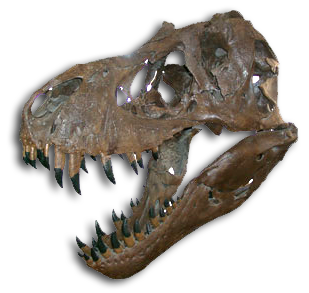Item Number
3078
Type
image
Description
anthracosaur
Size
41x15
Age
Paleozoic, Early Permian, Wolfcampian
SciId
Archeria Crassidisca
Status
in inventory
Display/Storage
Display
Building
Zuhl Museum
Original Site
Texas
Date Acquired
2020
Source
Paleotex LLC
Gallery/Room\Floor
Wow Gallery
Notes
Perhaps one of the most enigmatic anthracosaurs to be discovered. Archeria crassidisca is an embolomere that thrived during the Early Permian era and exhibited unique and fascinating characteristics. Embololmeres first evolved from reptile-like amphibians in the Early Carbonifereous period, and likely went extinct shortly after the time of Archeria. The animals were strongly specialized semiaquatic predators with elongated bodies developed for eel-like undulation swimming. This along with other anatomical differences show how the Archeria was an important part of the evolution of amphibians we see today. The skull of Archeria is distinguished by its crocodyloid appearance and long spatulate snout. Dentition likely indicates a piscivorous diet, with nearly 200 chisel-shaped teeth which are generally homogeneous in size, 6 remarkably large conical premaxillary teeth which are generally homogeneous in size, 6 remarkably large conical premaxillary teeth, and 8 conical pterygoid teeth. The vertebrae of embolomeres consist of pleurocentra and intercentra that are roughly equal in size whereas most other tetrapods' centras differ drastically in appearance. In the tail of Archeria, the henmal arches actually transition in placement from the intercentrum to the pleurocentrum, a feature that may have been an adaptation to help balance the tail during undulation. As of 2020, this composite is currently the only known fully restored skeleton of Archeria crassidisca. It is also one of the largest known specimens, measuring approximately 9 feet in length, with the tail comprising slightly over half the skeleton. It was constructed based on proportions from a 10.5 inch Archeria fossil jaw specimen from the Archer County Museum in Texas. This restoration also closely adheres to scientific research from publications by Robert Holmes and Alfred Romer. With fossil elements present in almost every part of skeleton, overall it is very comprehensive with approximately 65% real bone. The skull alone has been restored with 85% original bone fragments. Any missing anatomical features were cast or sculpted to complete the Archeria. Order- Embolomeri Family- Archeriidae Genus- Archeria Species- crasswidisca Locality: CR bonebed, near Olney, Archer County, Texas, USA. Age: Paleozoic, Early Permian, Wolfcampian
Preview

Description
Perhaps one of the most enigmatic anthracosaurs to be discovered. Archeria crassidisca is an embolomere that thrived during the Early Permian era and exhibited unique and fascinating characteristics. Embololmeres first evolved from reptile-like amphibians in the Early Carbonifereous period, and likely went extinct shortly after the time of Archeria. The animals were strongly specialized semiaquatic predators with elongated bodies developed for eel-like undulation swimming. This along with other anatomical differences show how the Archeria was an important part of the evolution of amphibians we see today. The skull of Archeria is distinguished by its crocodyloid appearance and long spatulate snout. Dentition likely indicates a piscivorous diet, with nearly 200 chisel-shaped teeth which are generally homogeneous in size, 6 remarkably large conical premaxillary teeth which are generally homogeneous in size, 6 remarkably large conical premaxillary teeth, and 8 conical pterygoid teeth. The vertebrae of embolomeres consist of pleurocentra and intercentra that are roughly equal in size whereas most other tetrapods' centras differ drastically in appearance. In the tail of Archeria, the henmal arches actually transition in placement from the intercentrum to the pleurocentrum, a feature that may have been an adaptation to help balance the tail during undulation. As of 2020, this composite is currently the only known fully restored skeleton of Archeria crassidisca. It is also one of the largest known specimens, measuring approximately 9 feet in length, with the tail comprising slightly over half the skeleton. It was constructed based on proportions from a 10.5 inch Archeria fossil jaw specimen from the Archer County Museum in Texas. This restoration also closely adheres to scientific research from publications by Robert Holmes and Alfred Romer. With fossil elements present in almost every part of skeleton, overall it is very comprehensive with approximately 65% real bone. The skull alone has been restored with 85% original bone fragments. Any missing anatomical features were cast or sculpted to complete the Archeria. Order- Embolomeri Family- Archeriidae Genus- Archeria Species- crasswidisca Locality: CR bonebed, near Olney, Archer County, Texas, USA. Age: Paleozoic, Early Permian, Wolfcampian 108
Keywords
anthracosaur Perhaps one of the most enigmatic anthracosaurs to be discovered. Archeria crassidisca is an embolomere that thrived during the Early Permian era and exhibited unique and fascinating characteristics. Embololmeres first evolved from reptile-like amphibians in the Early Carbonifereous period, and likely went extinct shortly after the time of Archeria. The animals were strongly specialized semiaquatic predators with elongated bodies developed for eel-like undulation swimming. This along with other anatomical differences show how the Archeria was an important part of the evolution of amphibians we see today. The skull of Archeria is distinguished by its crocodyloid appearance and long spatulate snout. Dentition likely indicates a piscivorous diet, with nearly 200 chisel-shaped teeth which are generally homogeneous in size, 6 remarkably large conical premaxillary teeth which are generally homogeneous in size, 6 remarkably large conical premaxillary teeth, and 8 conical pterygoid teeth. The vertebrae of embolomeres consist of pleurocentra and intercentra that are roughly equal in size whereas most other tetrapods' centras differ drastically in appearance. In the tail of Archeria, the henmal arches actually transition in placement from the intercentrum to the pleurocentrum, a feature that may have been an adaptation to help balance the tail during undulation. As of 2020, this composite is currently the only known fully restored skeleton of Archeria crassidisca. It is also one of the largest known specimens, measuring approximately 9 feet in length, with the tail comprising slightly over half the skeleton. It was constructed based on proportions from a 10.5 inch Archeria fossil jaw specimen from the Archer County Museum in Texas. This restoration also closely adheres to scientific research from publications by Robert Holmes and Alfred Romer. With fossil elements present in almost every part of skeleton, overall it is very comprehensive with approximately 65% real bone. The skull alone has been restored with 85% original bone fragments. Any missing anatomical features were cast or sculpted to complete the Archeria. Order- Embolomeri Family- Archeriidae Genus- Archeria Species- crasswidisca Locality: CR bonebed, near Olney, Archer County, Texas, USA. Age: Paleozoic, Early Permian, Wolfcampian 2020 Paleozoic, Early Permian, Wolfcampian Fossil
Keywords
anthracosaur Perhaps one of the most enigmatic anthracosaurs to be discovered. Archeria crassidisca is an embolomere that thrived during the Early Permian era and exhibited unique and fascinating characteristics. Embololmeres first evolved from reptile-like amphibians in the Early Carbonifereous period, and likely went extinct shortly after the time of Archeria. The animals were strongly specialized semiaquatic predators with elongated bodies developed for eel-like undulation swimming. This along with other anatomical differences show how the Archeria was an important part of the evolution of amphibians we see today. The skull of Archeria is distinguished by its crocodyloid appearance and long spatulate snout. Dentition likely indicates a piscivorous diet, with nearly 200 chisel-shaped teeth which are generally homogeneous in size, 6 remarkably large conical premaxillary teeth which are generally homogeneous in size, 6 remarkably large conical premaxillary teeth, and 8 conical pterygoid teeth. The vertebrae of embolomeres consist of pleurocentra and intercentra that are roughly equal in size whereas most other tetrapods' centras differ drastically in appearance. In the tail of Archeria, the henmal arches actually transition in placement from the intercentrum to the pleurocentrum, a feature that may have been an adaptation to help balance the tail during undulation. As of 2020, this composite is currently the only known fully restored skeleton of Archeria crassidisca. It is also one of the largest known specimens, measuring approximately 9 feet in length, with the tail comprising slightly over half the skeleton. It was constructed based on proportions from a 10.5 inch Archeria fossil jaw specimen from the Archer County Museum in Texas. This restoration also closely adheres to scientific research from publications by Robert Holmes and Alfred Romer. With fossil elements present in almost every part of skeleton, overall it is very comprehensive with approximately 65% real bone. The skull alone has been restored with 85% original bone fragments. Any missing anatomical features were cast or sculpted to complete the Archeria. Order- Embolomeri Family- Archeriidae Genus- Archeria Species- crasswidisca Locality: CR bonebed, near Olney, Archer County, Texas, USA. Age: Paleozoic, Early Permian, Wolfcampian 2020 Paleozoic, Early Permian, Wolfcampian Fossil


